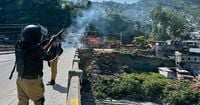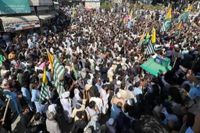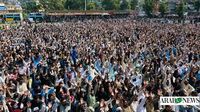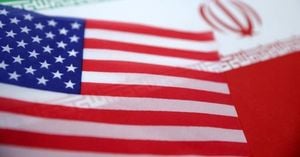In the restive region of Pakistan-administered Kashmir, a wave of violent protests and deadly clashes has thrown the area into turmoil, leaving at least nine people dead and more than 150 injured as of October 2, 2025. The unrest, which erupted after a coalition of civil rights groups known as the Jammu Kashmir Joint Awami Action Committee (JKJAAC) called for a region-wide lockdown, has prompted urgent government intervention and drawn national attention to the longstanding grievances of Kashmir’s residents.
According to the Associated Press, the violence reached a critical point earlier this week when thousands of demonstrators, some armed with sticks and guns, confronted police officers deployed to maintain order and guard government buildings. These confrontations, captured in video footage circulating online, showed the sheer scale and intensity of the clashes. The government confirmed that at least nine people, including three police officers, were killed, while more than 150—mostly policemen—suffered injuries. Some of the most severely wounded officers were transported to hospitals in Islamabad for treatment.
The protests began on September 29, 2025, when the JKJAAC, representing an alliance of civil society groups, issued a call for a complete shutdown across the region. Their demands included subsidies on food and electricity, the removal of perks for government officials, ending 12 seats in the regional assembly reserved for Kashmiri migrants from Indian-administered Kashmir, and a share of royalties from hydel power projects. According to The Sentinel Assam, the movement quickly gained traction, with workers and supporters from every city and town in Pakistan-administered Kashmir joining a long march toward the regional capital, Muzaffarabad. In Kotli, a total shutdown was observed, and in Dhirkot, a convoy of approximately 2,000 JKJAAC workers from Rawalakote and Bagh was met with police gunfire. Four civilians were killed and at least 16 people, including both protesters and police, were injured during this particular confrontation.
Meanwhile, in Muzaffarabad, around 2,000 people staged a sit-in at Lal Chowk, later shifting to the city’s bypass to await the arrival of additional convoys. Reports indicated that Pakistani security forces responded with aerial firing and tear gas shelling, resulting in two more civilian deaths. In another flashpoint, Dadyal, police opened fire on a convoy of JKJAAC workers from Chakswari and Islamgarh, killing two and injuring approximately ten others. By October 3, 2025, the death toll in the protests had crossed a dozen, highlighting the severity of the government’s response to what began as a call for economic relief and political reforms.
Amid mounting casualties and escalating tensions, Prime Minister Shehbaz Sharif dispatched a high-level government delegation to Muzaffarabad for talks with protest leaders. In a statement, Sharif appealed for calm and urged police to exercise restraint, reiterating his government's commitment to addressing public grievances in the region. “We should keep the regional and global situation in view amid this crisis,” said Ahsan Iqbal, a member of the negotiations committee, in remarks to state television. “Our enemy country will not waste a single second in capitalizing on a crisis situation in our country. And we should avoid lighting a fire through which our enemy can benefit and tarnish the image of Pakistan, cause unrest in Pakistan or the loss of life and property of the people.” Iqbal’s reference to “our enemy country” was widely understood to mean India, underscoring the sensitivity of Kashmir’s status in the longstanding rivalry between the two nations.
The government’s negotiating team included Senator Rana Sanaullah, federal ministers Sardar Yousaf and Ahsan Iqbal, former Azad Jammu and Kashmir (AJK) president Masood Khan, and Qamar Zaman Kaira. Despite this high-profile intervention, the first round of talks in Muzaffarabad failed to yield a breakthrough. Shaukat Nawaz Mir, a senior JKJAAC member, told reporters, “We, the members of the [JKJAAC] core committee, will hold consultations and then we will make a decision.” The impasse left the prospect of further demonstrations hanging in the balance, as a convoy of buses and cars continued to move toward Muzaffarabad for another mass protest, according to local authorities cited by the Associated Press.
Chaudhry Anwarul Haq, the region’s prime minister, acknowledged the gravity of the situation and reiterated his administration’s willingness to engage in dialogue. “For resolving any conflict, the best and most well-known way in the world, which has been used continuously and will continue to be used, is through dialogue,” Haq said at a press conference. He revealed that his government had already agreed to accept 36 out of the alliance’s 38 demands—including cheaper wheat, reduced electricity tariffs, and local governance reforms—but lamented that protest leaders had refused to call off their agitation. “The government is ready to talk to you [JKJAAC], your legitimate demands will be resolved as soon as possible. The path of violence will only go toward the loss of human lives.”
Interior Minister Mohsin Naqvi visited Islamabad’s main hospital on October 2 to meet officers wounded in the clashes. He praised the “courage and restraint” of the security forces and directed doctors to provide the best possible medical treatment. Naqvi also warned that “no one will be allowed to take the law into their own hands,” suggesting that some violent elements were attempting to destabilize the region “at the behest of enemies.” This rhetoric was echoed on pro-government social media platforms, which portrayed the protests as instigated by external agencies rather than as an indigenous movement seeking redress for local grievances.
The current unrest is not without precedent. In May 2024, a similar wave of protests paralyzed the region, leading to six days of strikes and violent clashes that left at least four people dead. At that time, Prime Minister Sharif approved a grant of Rs 23 billion (about $86 million) for subsidies on flour and electricity and established a judicial commission to review elite privileges. Protest leaders suspended their campaign but warned that failure to implement the package would fuel renewed unrest—a warning that now appears prescient.
As the government and protest leaders edge toward another round of negotiations, the population of Pakistan-administered Kashmir waits anxiously. The region remains on a knife’s edge, with roads blocked, businesses shuttered, and the threat of further violence looming large. Whether dialogue can succeed where force has failed remains to be seen, but for now, the people of Kashmir are caught between the hope of reform and the harsh reality of unrest.






